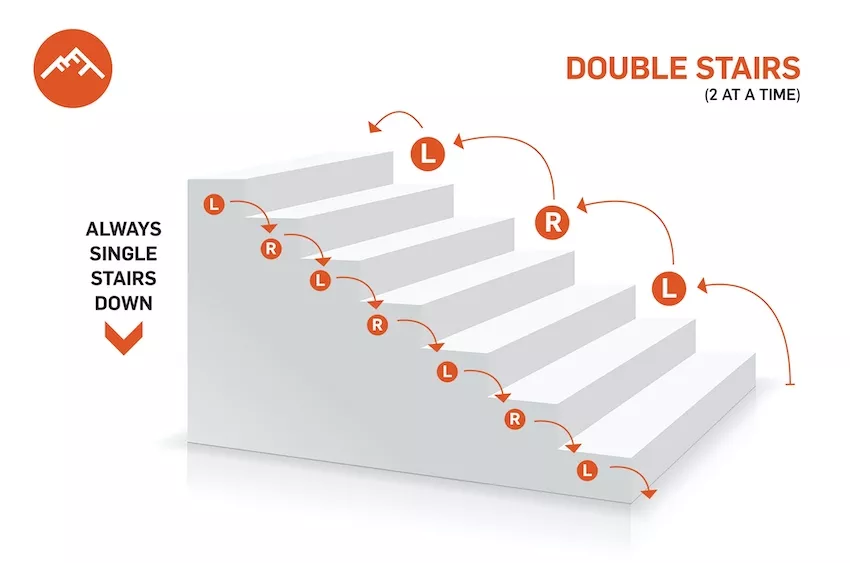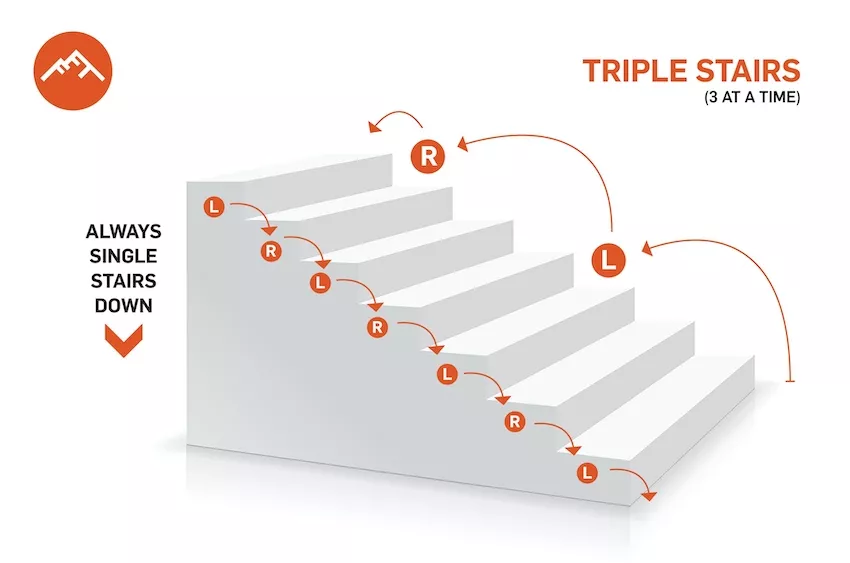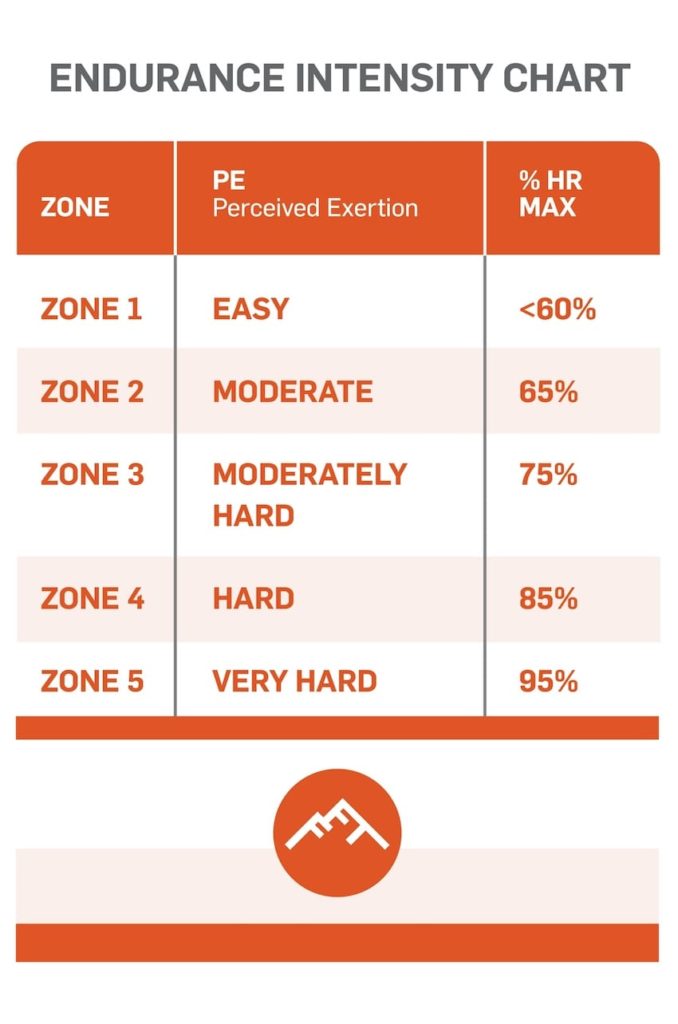8 Safe and Effective Stair Workouts for Beginner to Advanced Exercisers

“Stairs workout” and similar keywords get about 20,000+ related Google searches monthly. That’s a significant amount of interest in these types of workouts, which is why I wanted to give my two cents. Below are effective guidelines to get you started or advance your current stairs workout. Let’s first start with detailing the 8 suggested workouts, then detail safety practices, tips, and goal recommendations at the end.
1) Single Stairs Workout
Anyone with generally healthy knees and hips can walk single stairs.
Beginners: 5-15 minutes
Intermediate: 20-30 minutes
Advanced: 30+ minutes

2) Double Stairs Workout
If the stair tread width (flat part of the stair) is short, most of you can reach up to two stairs at a time.
Intermediate: 15-30 minutes
Advanced: 30+ minutes

3) Triple Stairs Interval Workout
This may be unachievable if you have short legs unless you assist yourself by pulling on the banister, but try it anyway! If you’re unable to reach 3 stairs, then perform this workout with 2 stair intervals.
Intermediate: Every 5 minutes you walk stairs (single or double), perform triple stairs for 1-3 minutes. Then switch back to 5 minutes of stair walking. Repeat for at least two total reps.
Advanced: Every 5 minutes you walk double stairs, perform triple stairs for 2-5 minutes. Then switch back to 5 minutes of walking. Repeat for at least three total reps.

4) High Intensity Stair Workout Bursts
Warm-up 10-15 minutes walking up and down using the single or double technique.
Intermediate: 50-75% speed/effort for 15-60 seconds. Rest 1.5 minutes between efforts. Repeat 5-10 times.
Advanced: 75-100% speed/effort for 60+ seconds. Rest 1-1.5 minutes between efforts. Repeat 8-15 times depending on how long your effort intervals last.
*Rule of thumb: Run up the stairs two at a time and run down as though you were late to an appointment.
5) Beginner Stair Workout Integrating Leg Strength
Perform 3-5 minutes of stair work followed by 1-3 beginner-level lower body exercises.
Repeat for a total of 2-3 times.
Beginner lower-body exercise choices:
6) Intermediate Stair Workout Integrating Leg Strength
Perform 3-10 minutes of stair work followed by 2-3 intermediate-level lower body exercises.
Repeat for a total of 2-4 times.
Intermediate lower-body exercise choices:
7) Advanced Stairs Workout Integrating Leg Strength
Perform 5-10 minutes of stair work followed by advanced-level lower body exercises.
Repeat for a total of 3-5 times.
Advanced lower-body exercise choices:
- Bulgarian Squat (Rear Elevated Split Squat)
- Single Leg Squat
- Elevated Front Foot Reverse Lunge with Hip Flexion
- Single Leg Lean over
- Alternating Forward/Reverse Lunges
8) Stairs Workout Plus Leg Strength
Complete any workout 1-4 detailed above, then rest for a few minutes or immediately continue by selecting 1 to 5 lower body exercise choices detailed above or include your own.
Safety Practices & Tips for Stairs Workout Success
Keep Your Feet Injury Free for Stair Workouts
When you first begin stair training, give consideration to the stress on the fascia beneath your feet, the calves, Achilles tendons, and feet in general. Prevent or lessen chances of acute or overuse joint and tendon issues by sticking to the progression below. If you are an avid hiker or runner, begin training at the intermediate or advanced level.
Beginner (Weeks 1-4): Place your foot flat as you ascend the stairs. In other words: distribute your weight evenly on the bottom of the feet. Performing this technique will help your lower leg and foot acclimate to the stress of your stairs workout. It is physically demanding when forces are placed entirely on the balls of the feet. This method minimizes the potential for injury by displacing the stress throughout the entire foot.
Intermediate (Weeks 5-8): Place your foot flat and rock to balls of the feet as you push off and ascend to the next step(s).
Advanced (Weeks 9-15): Stay on balls of feet for ½ to ¾ the stair workout time.
Warm-up First to Avoid Tendonitis and Other Soft Tissue Problems
Those who exercise frequently may begin their stair workout immediately, although a slow pace at the beginning is recommended. A warmup is recommended before you increase the pace and intensity of your workout.
Beginner: Walk around for 10 minutes before performing your stairs workout.
Intermediate: You may perform single stairs and progress to double and triple stairs (at a slow pace) instead of a walking warmup.
Advanced: You may try double or triple stairs (again, at a slow pace) instead of a walking warmup.
Three Goals Used to Stay Motivated For Stair Workouts
#1 – Track Elevation Gain or Laps
Elevation gain is a good goal for workouts 1-3 and 8. This method is accurate even if you mix up your stair training locations. Tracking laps can work if you plan on using the same stairs for your workout every time. You can also convert laps to elevation gain using the elevation gain stair calculator.
Convert Laps to Elevation Gain with Calculator Below
#2 – Monitor Intensity Such as Heart Rate or Perceived Exertion
Workouts 4-7 detailed above are based on intensity measured by either % Max Heart Rate or Perceived Exertion. You can track averages or highs if you use a HR monitor, but if you don’t, you can refer to the Perceived Exertion scale below. Your stairs workout intensity will generally range from ZONE 2 – ZONE 4. ZONE 5 is reserved for High Intensity Stair Workout Bursts detailed above.

#3 – Track Your Workout Time
You can simply train for time and maintain a constant pace for specified minutes. If you begin to lose motivation, however, you can employ goals #1 or #2.
Where Will You Perform Your Stairs Workout?
Join the Friends of Public Stairs Facebook group and ask members for stair-location recommendations in your area. Keep in mind that you can use staircases at home, stairs at parking garages, bleachers at a sports stadium, stairs at the beach, or even stairwells at an office or hotel.
A safely executed stairs workout performed over the next few months will perhaps get you in the best shape you have ever been. If you are a hiker, you will ascend and descend trails with astounding confidence. If you are a runner you will feel stronger and more durable. Even road and mountain bikers will reap the rewards from weekly stair workouts.
If you want to have a chat about staircase workouts then feel free to schedule a time to discuss or request more information about custom training programs.



Rob S.
Great methods to consider when it comes to stair workouts. Not only do these provide results, when done over the long term, but they’re varied enough to where working out doesn’t feel like a chore.
Laura B
I’m good on the up. What tips do you have for building strength going downhill on hikes?
Marcus Shapiro
Hi Laura. Stair workouts require your having to tolerate the stresses of descending; so that’s built in. However, you’ll find some great advice in this article, which details 7 downhill training strategies.
Beginner Exercise
The “8 Safe and Effective Stair Workouts” by Marcus Shapiro provides a fantastic guide for anyone looking to incorporate stair workouts into their routine. I appreciate the detailed progression from beginner to advanced levels, making it accessible for all fitness levels. The emphasis on safety practices, like warming up and foot placement, is crucial for preventing injuries. Including strength exercises alongside stair workouts is a great way to enhance leg strength and overall fitness. The motivation tips, such as tracking elevation gain and monitoring heart rate, can really help keep participants engaged. Overall, this is an excellent resource for effective stair training!